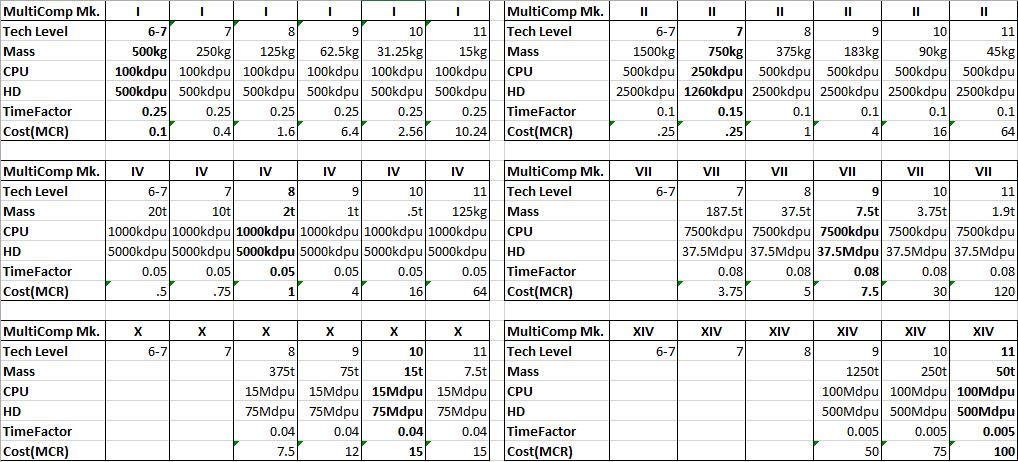Difference between revisions of "Space Opera Computers"
m (→Multicomps) |
m (→Personal Computers) |
||
| Line 13: | Line 13: | ||
Cultures of varying tech levels can produce MultiComps of similar power. Higher tech levels can produce them in smaller sizes. The machines are grouped by performance, and share a same number, or Mark (MK). The entry in bold is the default MK for that tech level. If a column has no entry, the given tech level cannot produce a machine of that capability. | Cultures of varying tech levels can produce MultiComps of similar power. Higher tech levels can produce them in smaller sizes. The machines are grouped by performance, and share a same number, or Mark (MK). The entry in bold is the default MK for that tech level. If a column has no entry, the given tech level cannot produce a machine of that capability. | ||
| − | = | + | =MiniComps= |
| − | Personal computers | + | MiniComps are Personal computers like tablets, phones and laptops. They could be standalone devices or built into a vehicle or larger device. MiniComps can run programs just like a MultiComp, but not nearly as many at a time. There will not be extensive rules and specs on these pieces of equipment, mostly, just their costs will be relevant. If demand determines that specs are required, I will develop them. |
MiniComp I (TL 6-7): 40<br> | MiniComp I (TL 6-7): 40<br> | ||
Latest revision as of 11:46, 22 February 2013
The computers in the Space Opera book are rated in DPU, which are 'data processing units', which is a great way to do things (since its totally fabricated), until they get stupid and try and try and relate how many DPU equals a current computing term. Ignore any of that crap. Lets assume that a DPU is some indeterminate ridiculously huge number of cycles or vibrations or instructions or terabytes. As long as we do that, things arent nearly as stupid as they could be.
Multicomps
MutiComps are multifunction, cross purpose machines capable of performing the needs of any enterprise: commercial, government or military. These MultiComps include all the terminals, networking gear and peripherals that could be utilized by the user. The stated mass is not necessarily contained in a single unit, it could be spread among many terminals or racks, simulating data centers.
Time Factor is the speed relative to a Minicomp of the given tech level. This means a MultiComp I is 4 times as fast as a MiniComp I.
Alternate Tech Levels
Cultures of varying tech levels can produce MultiComps of similar power. Higher tech levels can produce them in smaller sizes. The machines are grouped by performance, and share a same number, or Mark (MK). The entry in bold is the default MK for that tech level. If a column has no entry, the given tech level cannot produce a machine of that capability.
MiniComps
MiniComps are Personal computers like tablets, phones and laptops. They could be standalone devices or built into a vehicle or larger device. MiniComps can run programs just like a MultiComp, but not nearly as many at a time. There will not be extensive rules and specs on these pieces of equipment, mostly, just their costs will be relevant. If demand determines that specs are required, I will develop them.
MiniComp I (TL 6-7): 40
MiniComp II (TL 7): 100
MiniComp III (TL 8): 250
MiniComp IV (TL 8): 500
MiniComp V (TL 9): 1000
MiniComp VI (TL 10): 2000
MiniComp VII (TL 11): 3500
Battlefield Computers
BattleComputers are relatively compact units designed for use in fighting vehicles and by Power Armour and spacesuited personnel. The units improve hit probabilities in fire and possible hand to hand combat.

